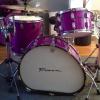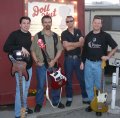gui_SURF_tar

Joined: May 04, 2010
Posts: 175
norway
|

Posted on Sep 20 2010 09:23 AM
hey lads. i just finished my 5g15 reverb unit and now i got some questions i hope you guys can answer.
1 is it normal to get slight drop in volume going trough the unit
compared to plugging right into amp?
- im kinda bummed over the reverb. didnt get the drip i was hoping for.got an danelectro spring king and its almost the same thing?
could this just be the 3spring belton pan or am i missing something
thx
|
LaFleur

Joined: May 20, 2009
Posts: 525
Leipzig


|

Posted on Sep 20 2010 09:33 AM
|
SlacktoneDave

Joined: Jul 01, 2006
Posts: 657


|

Posted on Sep 20 2010 09:44 AM
gui_SURF_tar
hey lads. i just finished my 5g15 reverb unit and now i got some questions i hope you guys can answer.
1 is it normal to get slight drop in volume going trough the unit
compared to plugging right into amp?
- im kinda bummed over the reverb. didnt get the drip i was hoping for.got an danelectro spring king and its almost the same thing?
could this just be the 3spring belton pan or am i missing something
thx
Re:1 Yes, the higher you raise the Mix knob, the more loading occurs with a small drop in volume.
Re 2: A two spring reverb pan will be capable of a more dripping sound. The 3 spring is more of a washed out sound, not the sound of a trad Reverb Unit with the "ping". Finding a decent new pan may be a challenge. I was surprised at what Dario could pull out of a new pan with his reverb unit, so, there is hope!
PS: The guy who made my 2nd Slacktone made a Weber reverb unit, it sounds really good, so stay with it!
|
gui_SURF_tar

Joined: May 04, 2010
Posts: 175
norway
|

Posted on Sep 20 2010 10:13 AM
thx alot guys. i`ve got to find me a pan then.!
moore tips on getting this thing to roar are welcome.
read somewhere that the capacitator going from the dwell controll to ground could affect the reverb
sound? but this is way over my noob head 
|
Icetech

Joined: Dec 16, 2006
Posts: 892
Macomb Mich
|

Posted on Sep 20 2010 11:22 AM
I have 3 old ass accutronics pans and 1 MOD.. i keep the MOD in my unit.. very happy with that pan and the quality is damn nice..
— I wanna play just like him when i grow up...
|
dboomer

Joined: Jan 05, 2009
Posts: 262
Port Hueneme, CA


|

Posted on Sep 20 2010 02:07 PM
SlacktoneDave
gui_SURF_tar
Re 2: A two spring reverb pan will be capable of a more dripping sound. The 3 spring is more of a washed out sound, not the sound of a trad Reverb Unit with the "ping".
yeah ... that's why they went to the 3 spring units. They wanted to smooth over the "boink"
There used to be one made in the 70's called a Clover. It used a pair of single springs as opposed to the Accutronics Type 4 pan (your basic Fender spring unit) which uses 4 springs connected in two pairs. Each spring has a left handed half and a right handed half to avoid "boink"
|
dp

Joined: Feb 26, 2006
Posts: 3546
mojave desert, california





|

Posted on Sep 20 2010 02:25 PM
i dig the boink , and the glassy shimmer of moderate reverberation...
and when you get them to feedback ever so slightly, you open up the heavenly chorus...but, that's getting into hearing damage sound pressure levels for sure...
|
D22

Joined: Apr 20, 2006
Posts: 2056


|

Posted on Sep 20 2010 06:26 PM
SlacktoneDave
.. I was surprised at what Dario could pull out of a new pan with his reverb unit, so, there is hope!
Thanks Dave. 
—
|
dannylectro

Joined: Aug 18, 2008
Posts: 373
Orange, CA




|

Posted on Sep 20 2010 07:58 PM
Icetech
i keep the MOD in my unit.. very happy with that pan and the quality is damn nice..
I love the MOD tank too. Beats the hell out of the new Belton-made Accutronics tank.
|
DannySnyder

Joined: Mar 02, 2006
Posts: 11079
Berkeley, CA











|

Posted on Sep 20 2010 08:16 PM
dboomer
There used to be one made in the 70's called a Clover. It used a pair of single springs as opposed to the Accutronics Type 4 pan (your basic Fender spring unit) which uses 4 springs connected in two pairs. Each spring has a left handed half and a right handed half to avoid "boink"
I believe the theory behind the 2 pairs of springs is that each spring is slightly different and coupling them eliminates the tendency to ring at a resonant frequency.
— Danny Snyder
"With great reverb comes great responsibility" - Uncle Leo
I am now playing trumpet with Prince Buster tribute band 'Balzac'
Playing keys and guitar with Combo Tezeta
Formerly a guitarist in The TomorrowMen and Meshugga Beach Party
Latest surf project - Now That's What I Call SURF
|
MissingLink

Joined: Jul 23, 2008
Posts: 488
Edge of the East China Sea


|

Posted on Sep 20 2010 10:59 PM
Icetech and Dannylectro are right about the better quality of MOD vs. Accutronics.
Having said that, though, I followed some advice found elsewhere on SG101 and shimmed the transducers in my Accu pan. (I think it was Danny who described the procedure.)
These alterations did a lot to make the Accu about as responsive as the MOD pan. They still sound different; the former is more 'tinny' and the latter is a bit darker-sounding. I've got the Accu in my outboard unit and I'm pretty happy with the sound these days. The MOD just went into my amp as part of an overhaul, but it's still in the shop -- can't get it back till Lunar New Year is over. Hmm... It would be more sophisticated if the pics were interspersed with the text, but I can't get it to do that. This'll have to do!
image
image
image
|
dboomer

Joined: Jan 05, 2009
Posts: 262
Port Hueneme, CA


|

Posted on Sep 21 2010 12:18 AM
MissingLink
I followed some advice found elsewhere on SG101 and shimmed the transducers in my Accu pan. (I think it was Danny who described the procedure.)
Can't quite see what you mean. Is this the equivalent of "potting" a pickup?
|
dboomer

Joined: Jan 05, 2009
Posts: 262
Port Hueneme, CA


|

Posted on Sep 21 2010 12:21 AM
DannySnyder
I believe the theory behind the 2 pairs of springs is that each spring is slightly different and coupling them eliminates the tendency to ring at a resonant frequency.
Yes ... but the left hand/right hand is to counteract twisting. A difference between the single spring and the 2 piece "single spring is you lose a lot of highs because of the mechanical coupling.
|
DannySnyder

Joined: Mar 02, 2006
Posts: 11079
Berkeley, CA











|

Posted on Sep 21 2010 12:31 AM
dboomer
DannySnyder
I believe the theory behind the 2 pairs of springs is that each spring is slightly different and coupling them eliminates the tendency to ring at a resonant frequency.
Yes ... but the left hand/right hand is to counteract twisting. A difference between the single spring and the 2 piece "single spring is you lose a lot of highs because of the mechanical coupling.
That may be, but I think most tanks have no trouble getting too trebly, so perhaps it's beneficial to have that affect as well.
— Danny Snyder
"With great reverb comes great responsibility" - Uncle Leo
I am now playing trumpet with Prince Buster tribute band 'Balzac'
Playing keys and guitar with Combo Tezeta
Formerly a guitarist in The TomorrowMen and Meshugga Beach Party
Latest surf project - Now That's What I Call SURF
|
MissingLink

Joined: Jul 23, 2008
Posts: 488
Edge of the East China Sea


|

Posted on Sep 21 2010 02:22 AM
dboomer
MissingLink
I followed some advice found elsewhere on SG101 and shimmed the transducers in my Accu pan. (I think it was Danny who described the procedure.)
Can't quite see what you mean. Is this the equivalent of "potting" a pickup?
Well, for me it was about removing the physical play at the transducer attachments. I sliced matchsticks and shoved them into the gaps to prevent the excess movement that results from the modern-day Accutronics method of construction. According to MOD's own blurb, their vintage-style manufacturing reduces signal interference:
"Some of the major differences between the MODs and other reverb tanks are that the transducers are wired directly to their respective RCA jacks as opposed to current production tanks where transducers are connected by a detachable plug to their respective RCA jacks. This makes the tanks less receptive to any outside interference. The original Hammond Accutronics tanks from the 1960's were also wired directly to their respective RCA jacks."
Does that mean the shims also have a shielding effect? Maybe. My reasoning was that since transducers change kinetic energy into electrical, any wasted motion could harm the process. The obvious experiment would be to make metal shims and see if they effect the same improvement as wooden ones.
Here's the vintage Accu pan from my amp (yeah, I know, it's only got one spring). You can see what the quote above is referring to in terms of direct connection. With the MOD, there was no need to shim anything, as its construction resembles that of the vintage pans.

It should be made clear, assuming it isn't blindingly so already, that I know next to nothing about this stuff! I just learn by reading and then doing. What is certain is that shimming the transducers in the Accutronics pan helped enough that I came to slightly favor it over the MOD pan -- which was itself a big improvement over the stock Accu.
Edit: Having had another look at the photos above, it seems that the tiny slivers of wood being used are hardly going to provide a comprehensive shielding effect.
|
Apache

Joined: Sep 21, 2010
Posts: 2
|

Posted on Sep 21 2010 11:26 AM
Rather than shims, I have used a vise with plastic jaws to very carefully apply pressure between the end of the laminations and the black plastic base. The idea was to reduce the play between the coil form, laminations and the plastic base. The laminations push against the coil form and force it against the plastic base. Im not sure if reducing the play helps much as I have some vintage tanks with lose coils that sound great. You could simply apply a little nail polish between the coil form and the laminations to hold it in place. When building my Weber reverb unit, I found that a vintage tank and vintage tubes provided the most improvement. The transducers on the new tanks are completely different. Different size coil form, different thickness laminations and composition, different magnet, different support wire and connection to the spring. The old transducers had good physical contact to the springs that dont require glue and in my opinion transmit and receive the high frequencies better. They are probably made out of a different material as well. I believe the new tanks try to eliminate the use of beryllium copper and high nickel content laminations to reduce cost and pollution. Not all old tanks sound good either. A friend and I tested 10 vintage tanks and compared those to the best new Accutronics & Belton tanks we could find. Each vintage tank had a unique sound and some were not so good, but they all sounded better than the new tanks. It appears that there may also be a combination effect of impedance matching between the tubes, output transformer and tank transducers. The pluck effect is usually related to the power level into the tank. The Weber kit has a larger power and output transformer to drive the tank harder. I've heard that one specific player from the 60's replaced the reverb output transformer with a Champ Amp output transformer. A good reverb sound is a combination of components, settings and your ears. 
|
gui_SURF_tar

Joined: May 04, 2010
Posts: 175
norway
|

Posted on Sep 24 2010 12:02 PM
thx for all the good tips guys.
but i had time to test the tank alittle today and im now pretty sure theres
something wrong with the output level. i played it trough my amp and
usually i set the volume to about 2. but with the tank plugged in i had to
set the knob to about 6 or 7 to get the same volume?
any ideas on where to start looking??
thx
|






























